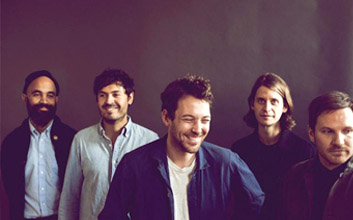Whispers of new material from Fleet Foxes have been circulating for many months now. Hype has slowly been building for a new record, with teasers from the band saying that the follow-up to their 2011 epic Helplessness Blues was very close to being done emerging at the tail end of last year.
Last week they were announced as the first band on the Vivid 2017 lineup, and now the band are officially ‘back’, armed with a new track and details of a new LP called Crack-Up.

Fleet Foxes are finally back with new track Third of May / Ōdaigahara and details on their first album in 6 years, Crack-Up.
The track is a 9-minute epic called Third of May / Ōdaigahara, a bold and adventurous folk hymnal very much in the vein of Helplessness Blues standouts The Plains / Bitter Dancer and The Shrine / An Argument.
Hear the track below.
Fleet Foxes frontman Robin Pecknold also have Pitchfork an exclusive first interview about the record. Read a snippet below.
Pitchfork: You once commented that the album title, Crack-Up, was inspired by a few things: an F. Scott Fitzgerald essay of the same name, your arrangement and editing approach, and the initials of your alma mater, Columbia University. How does that Fitzgerald essay relate to the album, and how would you describe your recording process?
Robin Pecknold: The first resonance was feeling like I’d cracked myself to some extent. I read the essay at a time when I wasn’t really sure what I cared about exactly, which is something Fitzgerald addresses a bit. I wasn’t focusing on music, I was trying to find other hobbies but nothing else had quite the same pull.
Beyond that, there are themes in the essay that come up a lot on the album, both lyrically and musically. The essay addresses the necessity of holding two opposing thoughts in one’s mind at once, in the “I can’t go on/I must go on” sense. I’ve struggled at times with finding a solid, objective reason to live, or I should say I’ve struggled with the notion of needing an airtight reason—almost anything you cling to can be explained away with logic in one way or another if you’re crafty enough. So that has meant coming around to making my own meaning, and finding meaning in connection to other people.
Lyrically, a lot of the album deals with perception, and the difference between how I have seen the world and how it actually is, in terms of people or situations or self-assessment, or any other permutation of the problem. As I get older I try and take people as they are and project less onto them, either good or bad, not make damsels or heroes or villains out of people who are just individuals doing their best with the hand they’ve been dealt.
As far as how the title relates to the structure of the album, the editing and arrangement, there are a number of songs where I wanted the transitions to feel jarring, non-linear, like you were watching a movie that has been edited partially out of sequence, like a Nicolas Roeg movie, or as if it’s a stained glass window that’s been shattered and reassembled.
Pitchfork: The Third of May 1808 is a famous Francisco Goya painting—a political piece that is ostensibly about resistance to a dictator, Napoleon. Did this factor into the title of the first single, “Third of May / Ōdaigahara”?
My friend and bandmate Skyler Skjelset’s birthday is May 3, and our album Helplessness Blues was released on May 3, 2011. The song “Third of May / Ōdaigahara” is about my relationship with Skye. It addresses our distance in the years after touring that album, the feeling of having an unresolved, unrequited relationship that is lingering psychologically. Even if some time apart was necessary and progressive for both of us as individuals, I missed our connection, especially the one we had when we were teenagers, and the lyrics for the song grew out of that feeling.
It felt like a funny coincidence to see a Goya painting called Third of May. The compounded coincidences, and how the whole experience of playing music with him itself felt like a series of lucky breaks and coincidences, left me feeling like it was a good phrase to use for the title of a song. Beyond that, though, the painting only served to inspire a few of the lyrics, like, “Aren’t we made to be crowded together like leaves,” or, “Stood, congregated, at the firing line,” but those lines are about Skye and I, and our time playing music together, and not the political events depicted in the painting.
Pitchfork: How did going to college shape the album, and what Fleet Foxes represents for you?
I went into college with a naive dropout’s idea of what people in college listened to, like maybe everyone was just jamming Nancarrow and Schoenberg on the quad, so when I was there I was honestly sort of embarrassed to say I was a musician from a pop context. I found academia intimidating, but in a good way, as if being that uncomfortable was helping me to grow. I thought maybe I’d attain some new level of intellectual justification for making music, but I didn’t really end up there. My thoughts on that remain scattered and subjective; I just had to throw up my hands and default back to: just trust your gut, go with what feels right, and let the reasons why it feels right remain somewhat mysterious.
Read the full article here.



